| Industry | Automotive industry |
|---|---|
| Founded | 1923 |
| Headquarters | Italy |
Area served | Worldwide |


| Industry | Automotive industry |
|---|---|
| Founded | 1923 |
| Headquarters | Italy |
Area served | Worldwide |


Eduardo Weber began his automotive career working for Fiat, first at their Turin plant (in 1914) and later at a dealership in Bologna. After WWI, with gasoline prices high, he reached a certain success in selling conversion kits for running trucks on kerosene instead. [1] The company was established as Fabbrica Italiana Carburatori Weber in 1923 when Weber produced carburetors as part of a conversion kit for Fiats. Weber pioneered the use of two-stage twin-barrel carburetors, with two venturis of different sizes (the smaller one for low-speed running and the larger one optimised for high-speed use).
In the 1930s, Weber began producing twin-barrel carburetors for motor racing, where two barrels of the same size were used. These were arranged so that each cylinder of the engine had its own carburetor barrel. These carburetors found use in Maserati and Alfa Romeo racing cars. Twin updraft Weber carburetors fed superchargers on the 1938 Alfa Romeo 8C competition vehicles. [2]
Fiat assumed control of the company in 1952 following Weber's disappearance in 1945. In time, Weber carburetors were fitted to standard production cars and factory racing applications from automotive marques such as Abarth, Alfa Romeo, Aston Martin, BMW, Chrysler, Ferrari, Fiat, Ford, IKA, Lamborghini, Lancia, Lotus, Maserati, Morgan, Porsche, Renault, Triumph and Volkswagen.
In 1986, Fiat also took control of Weber competitor Solex, and merged the two into a single company (Raggruppamento Controllo Motore, or the "Engine Management Group"). This was then reorganized as Magneti Marelli Powertrain S.p.A. in 1986. [3] Genuine Weber carburetors were produced in Bologna, Italy, up until 1992, when production was transferred to Madrid, Spain, where they continue to be made today. [1] Weber carburettors are made in a facility owned by LCN Automotive [4] based in Spain. There are only two direct distributors of Spanish Weber carburetors - Webcon [5] based in the UK and WorldPac known as RedlineWeber [6] in the US. Webcon operate a Global distribution chain via a long established network of Dealers and specialists, many of whom are located in the EU.
In modern times, fuel injection has replaced carburetors in both production cars and most modern motor racing, although Weber carburetors are still used extensively in classic and historic racing. They are also supplied as high-quality replacements for problematic OEM carburetors. Weber fuel system components are distributed by Magneti Marelli, Webcon UK Ltd., and, in North America, by several organizations, including Worldpac, marketing under the Redline name. Other suppliers include Overseas Distributing, Pierce Manifolds & Lynx Weber in Australia [ citation needed ]
Weber carburetors are sold for both street and off-road use, with the twin-choke sidedraft DCOE (Doppio Corpo Orizzontale E; "Double-Body Horizontal E") being the most common one. They are sold in what is referred to as a Weber conversion kit. A Weber conversion kit is a complete upgrade package consisting of a Weber carburetor, intake manifold or manifold adapter, throttle linkage, air filter, and all of the hardware needed for installation on a vehicle.
Weber carburetors are marked with a model code on the mounting flange, the body, or on the cover of the float chamber. [7] This begins with a number which originally indicated the diameter (in millimetres) of the throttle bore, but later lost this significance. If this number has a single pair of digits, both chokes are of the same diameter and operate together; if it has two pairs of digits separated by a stroke (e.g. 28/36), there are primary and secondary chokes that are opened one after the other, usually of differing diameter. [8]
These numbers are followed by a group of letters, which indicate various features: the DCOE is a sidedraft unit, all others being downdraft; the DCD has a piston-type starter valve as opposed to a strangler choke; and so on. [9] After the letters there will be a further number, which may be followed by a letter, e.g. 4B, 13A; these indicate the series, which in turn almost always indicates the original equipment fitment of the product. [10] The full designation might be 40 DCOE 29, 45 DCOE 9, etc. [11]
DCOE, IDF, IDA or DGV carburetors can be found made by other companies, like EMPI, FAJS or REEDMORAL, LOREADA, often at half the price of the originals. Often these are called 'fake' [12] by Weber users. All copies are manufactured in China and are 100% copy, so all parts are interchangeable. Operation however may vary from the original, due to inaccurate drilling and poorly calibrated parts. Mostly noticeable during idle or cruise. Although internal parts can be swapped for original [13]
Proper carburetor jetting is based on engine displacement, RPM and engine usage. Either one or more carburetors connected to each other are used. For small engines, even only one half of the carburetor was used, with the other half blinded and partially cut off. The basic carburetor size can be selected by the butterfly valves, for DCO/DCOE the sizes are 38/40/42/45/48/50/55, with 40/45/48/50/55 being more common and available today. Jet size is based on choke size, and choke size is just based on engine displacement, RPM and application. Today you can simplify the calculation work and use an online jetting calculator [14] or go through the jetting tables and match your case. [15]

A carburetor or carburettor is a device that mixes air and fuel for internal combustion engines in an appropriate air–fuel ratio for combustion. The term is sometimes colloquially shortened to carb in the UK and North America or to carby in Australia.

The Ford Essex V6 engine is a 60° V6 engine built between 1966 and 1988 by the Ford Motor Company in the United Kingdom and until 2000 in South Africa although mostly in the Ford engine plant of Dagenham, Essex, which gave the engine its name. It is closely related to the Ford Essex V4 engine produced in displacements of 1.7 L and 2.0 L. Both engines share many parts since the Essex V6 was directly derived from the Essex V4; the 2.0 L Essex V4 and the 3.0 L Essex V6 in fact have exactly the same bore and stroke and share various components.

The Alfa Romeo Alfasud is a small family car manufactured and marketed from 1971 to 1989 by Alfa Romeo as a front-engine, four-door, five passenger entry-level model over a single generation — with facelifts in 1977 and 1980. Alfa Romeo subsequently introduced a two-door wagon variant, the Giardinetta (1975); two-door coupe, the Alfasud Sprint (1976); three-door hatchback (1981) and five-door hatchback (1982).

Alfa Romeo Giulia is the name of three not directly related models by the Italian car manufacturer Alfa Romeo. The first is a line of sporty four-door compact executive cars produced from 1962 to 1978, the second is an updated, mainly up-engined Spider, Sprint and Sprint Speciale Giuliettas, and the third Giulia is a compact executive car unveiled in 2015.

The Alfa Romeo GTA is a coupé automobile manufactured by the Italian manufacturer Alfa Romeo from 1965 to 1971. It was made for racing (Corsa) and road use (Stradale).
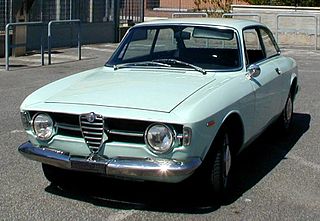
The Alfa Romeo 105 and 115 series coupés are a range of cars made by the Italian manufacturer Alfa Romeo from 1963 until 1977, based on a shortened floorpan from the Giulia saloon. They were the successors to the Giulietta Sprint coupé.
Designed by Aurelio Lampredi, the Fiat SOHC engine first appeared in the front-wheel drive (FWD) Fiat 128 of 1969. The in-line four-cylinder engine comprised an iron block with an aluminium cylinder-head containing a single overhead camshaft operating directly on both the inlet and exhaust valves in a reverse-flow cylinder-head configuration. The camshaft was driven by a belt rather than chain. The engine remained in production until about 2010 and grew in capacity over the years from 1100 cc to an eventual 1900 cc. The Fiat 130 2.9 L (2,866 cc) V6 engine, also appearing in 1969, although having crossflow cylinder head, is directly related to the 128 SOHC engine, but with a 1.20 upscale in bore and stroke. It was gradually replaced by the Pratola Serra engine series starting from 1995, although it was also converted to use a multivalve DOHC head, giving birth to the Torque engine, used until 2005.

Blue&Me is an integrated in-vehicle infotainment system used worldwide on many vehicles marketed by Fiat Chrysler Automobiles (FCA) from model years 2006–2017. With the exception of the Ford Ka, which is a lightly modified Fiat 500, the system is exclusive to Abarth, Alfa Romeo, Fiat and Lancia cars and to Fiat Professional's light commercial vehicles
The Quadrajet is a four barrel carburetor, made by the Rochester Products Division of General Motors. Its first application was the new-for-1965 Chevy 396ci engine. Its last application was on the 1990 Oldsmobile 307 V8 engine, which was last used in the Cadillac Brougham and full size station wagons made by Chevrolet, Pontiac, Oldsmobile, and Buick.

The Fiat 8V is a V8-engined sports car produced by the Italian car manufacturer Fiat from 1952 to 1954. The car was introduced at the 1952 Geneva Motor Show. The Fiat 8V got its name because at the time of its making, Fiat believed Ford had a copyright on "V8". With 114 made, the 8V wasn't a commercial success, but did well in racing. Apart from the differential the car did not share any parts with the other Fiats. The 8V was developed by Dante Giacosa and the stylist Luigi Rapi. The engine was a V8 originally designed for a luxury sedan, but that project was stopped.
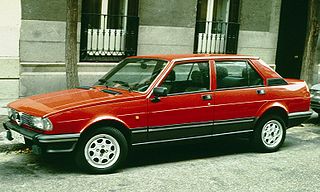
The Alfa Romeo Giulietta is a small executive saloon car manufactured by Italian car maker Alfa Romeo from 1977 to 1985. The car was introduced in November 1977 and while it took its name from the original Giulietta of 1954 to 1965, it was a new design based on the Alfa Romeo Alfetta chassis. The Giulietta went through two facelifts, the first in 1981 and the second one in 1983. All Giuliettas used 5-speed manual transmissions.

Selespeed is the name of an automated manual transmission used in Alfa Romeo cars, developed by Italian company Magneti Marelli and made by Graziano Trasmissioni.
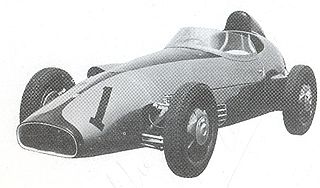
The Bandini formula junior is a racing car produced from 1959 to 1962 by the Bandini Automobili company of Forlì, Italy.
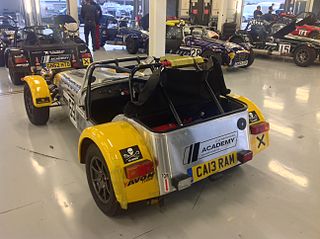
The Caterham Academy is a motor-racing championship exclusively open to novices, as their first foray into motorsport.

The Alfa Romeo Spider is a two-seater, front engine, rear drive roadster manufactured and marketed by Alfa Romeo from 1966 to 1994 in four distinct generations, or Series, each with modifications ranging from modest to extensive.
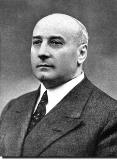
Edoardo Weber was an Italian engineer and businessman, famous for creating the Weber carburetor.

The Alfa Romeo Giulia is a compact executive car produced by the Italian automobile manufacturer Alfa Romeo. It was unveiled in June 2015, with market launch scheduled for February 2016, and it is the first saloon offered by Alfa Romeo after the production of the 159 ended in 2011. The Giulia is also the first mass-market Alfa Romeo vehicle in over two decades to use a longitudinal rear-wheel drive platform, since the 75 which was discontinued in 1992. The Giulia was second in 2017 European Car of the Year voting and was named Motor Trend Car of the Year for 2018. In 2018, Giulia was awarded the Compasso d'Oro industrial design award.

The Alfa Romeo Giulietta Sprint Speciale and Alfa Romeo Giulia Sprint Speciale, also known as Giulietta SS and Giulia SS, are small sports cars manufactured by Alfa Romeo from 1959 to 1966.

The Dino 206 GT, 246 GT and 246 GTS are V6 mid-engined sports cars produced by Ferrari and sold under the Dino marque between 1967 and 1974.